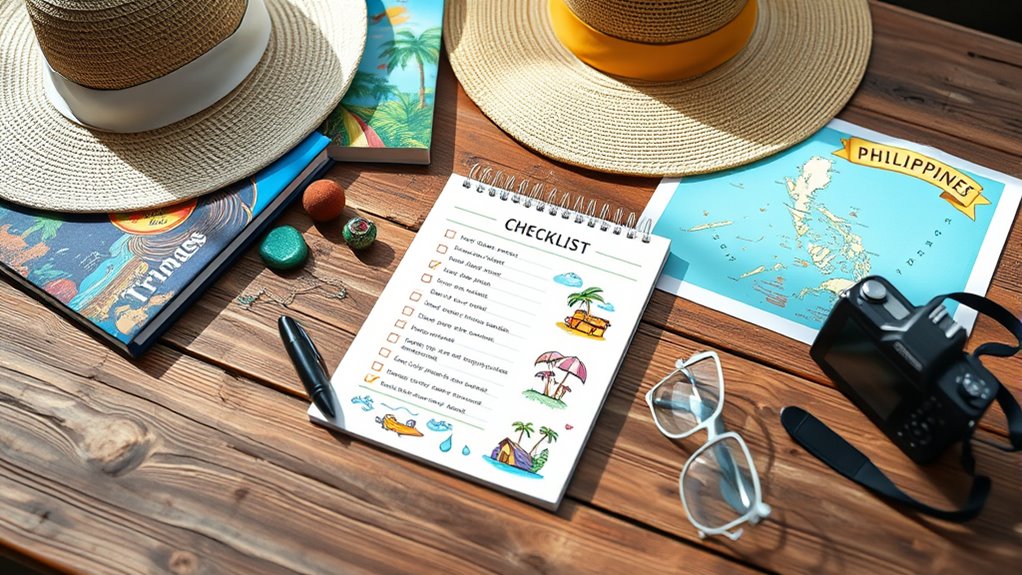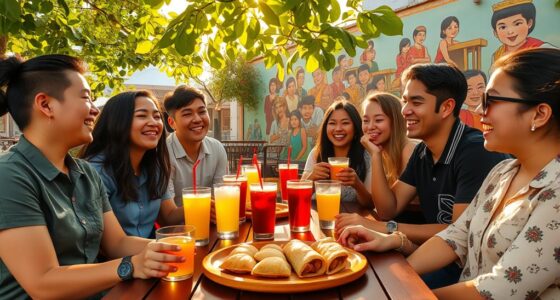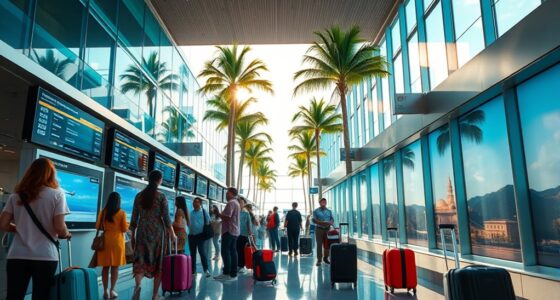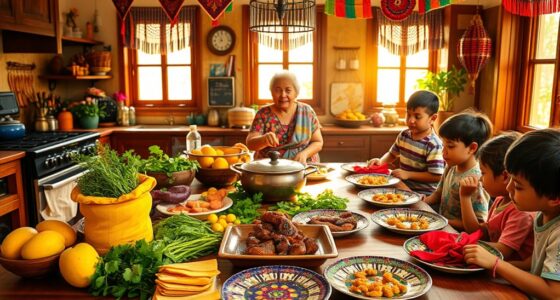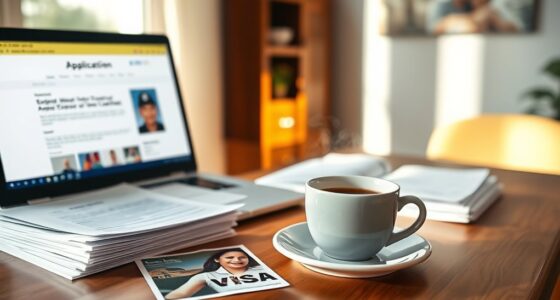When planning your first trip to the Philippines, start by ensuring your passport’s valid and checking visa requirements. Gather emergency contacts and travel insurance details. Keep an eye on the weather, pack breathable clothing, and bring essentials like sunscreen. Don’t forget your electronics and safety measures to protect your valuables. Familiarize yourself with local customs and budget for your activities. For more tips that’ll enhance your journey, keep exploring this essential checklist.
Key Takeaways
- Ensure your passport is valid for at least six months beyond your planned stay in the Philippines.
- Check visa requirements and gather necessary documents for urgent travel situations.
- Pack lightweight, breathable clothing, including essentials for both warm days and cooler evenings.
- Stay updated on health precautions, including vaccinations and malaria prevention, especially during the wet season.
- Keep emergency contacts and embassy information handy for safety and support during your trip.
Travel Documents and Emergency Contacts
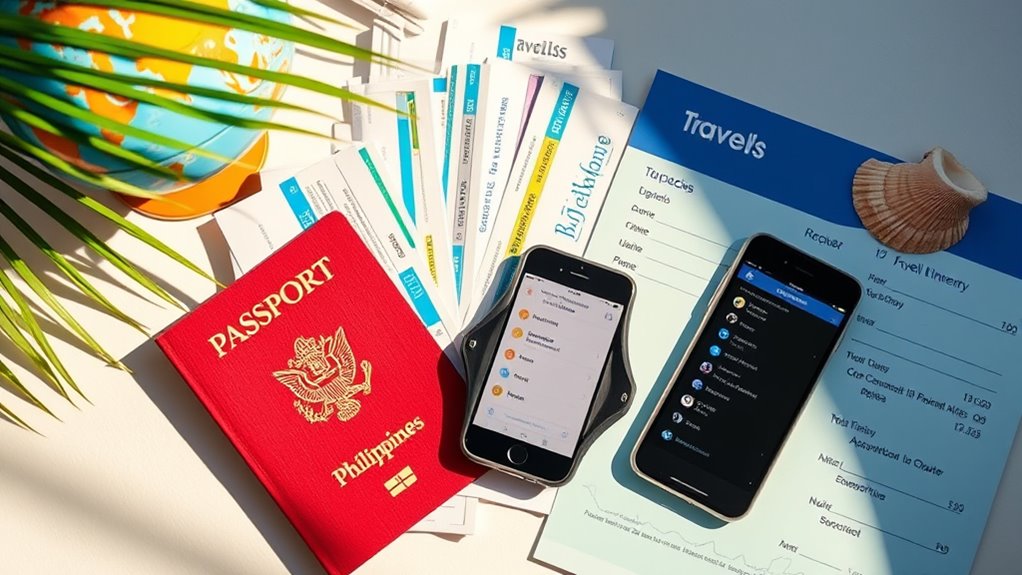
When planning your trip to the Philippines, it’s essential to have your travel documents in order and emergency contacts at your fingertips. Verify your passport is valid for at least six months beyond your stay.
Depending on your nationality, you might need a visa, but many travelers can obtain visas on arrival or eVisas. If you’re traveling for urgent reasons, gather proof, such as medical certificates, and consider applying for an emergency passport if your original is lost.
Keep embassy contact numbers, local emergency numbers, and family details handy. It’s also wise to have travel insurance.
Ensure you have embassy contacts, local emergency numbers, and family details readily available, along with travel insurance for peace of mind.
Organize all documents securely, keeping both physical and digital copies, so you’re prepared for any situation while exploring the beautiful Philippines.
Weather Forecast and Health Precautions
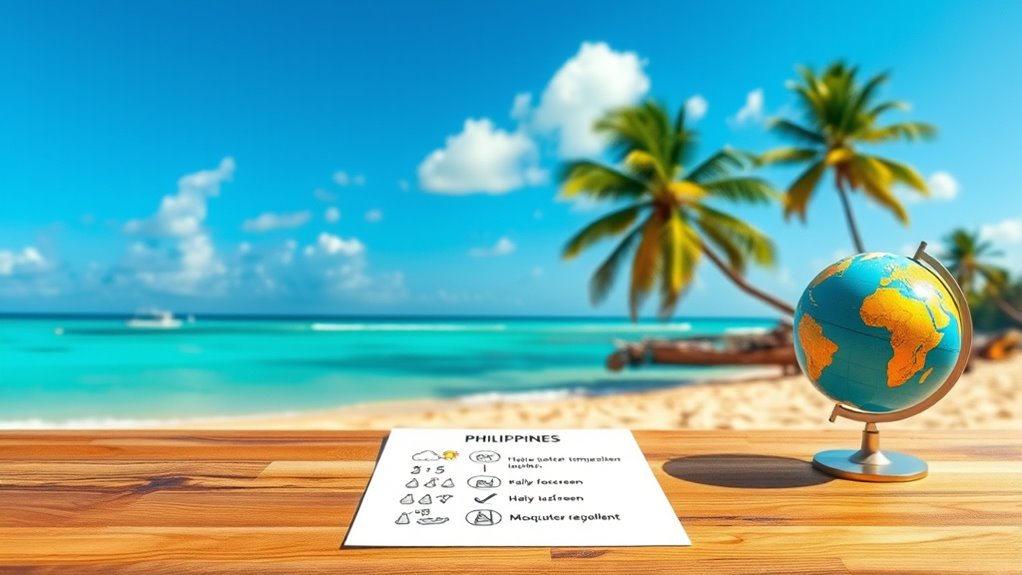
Understanding the weather and health precautions is essential for enjoying your trip to the Philippines. The country has a dry season from November to April and a wet season from May to October, with temperatures ranging from 23°C to 35°C.
Be aware that typhoons can affect travel plans between August and January. Make sure you’re up-to-date on vaccinations, and take precautions against malaria and dengue by using insect repellent.
Sun protection is critical during the dry months, so pack sunscreen and hats. Staying hydrated is important, especially from March to May.
Finally, remember that access to medical facilities varies; major cities offer better care, so plan accordingly. Stay informed about local health advisories for a safe trip.
Clothing and Footwear Essentials
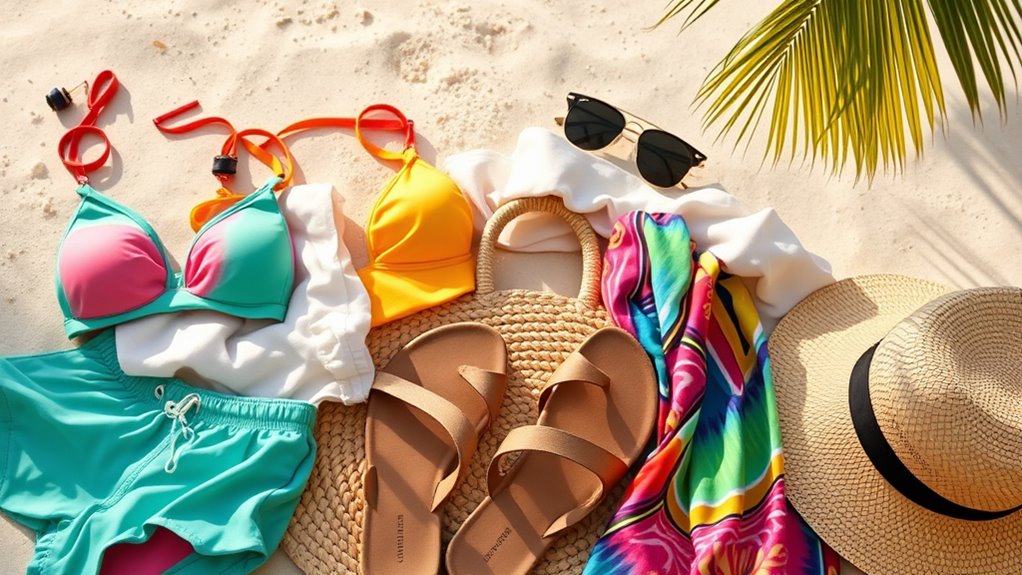
Preparing for your trip to the Philippines means considering what to wear and pack for the climate and activities. Bring breathable t-shirts (2-3 pairs) for daily wear, quick-dry shorts (1-2 pairs) for outdoor fun, and full-length pants for cooler evenings.
Don’t forget a long-sleeved outer layer for places like Baguio and a dressier outfit for city nights in Manila.
For footwear, pack hiking shoes for exploring, flip flops for the beach, and optional water shoes for water sports. A pair of dress shoes will suit upscale venues.
Remember socks for trekking or cooler nights. Opt for lightweight fabrics and packable clothing for ease, ensuring you stay comfortable and stylish throughout your journey.
Electronics and Accessories
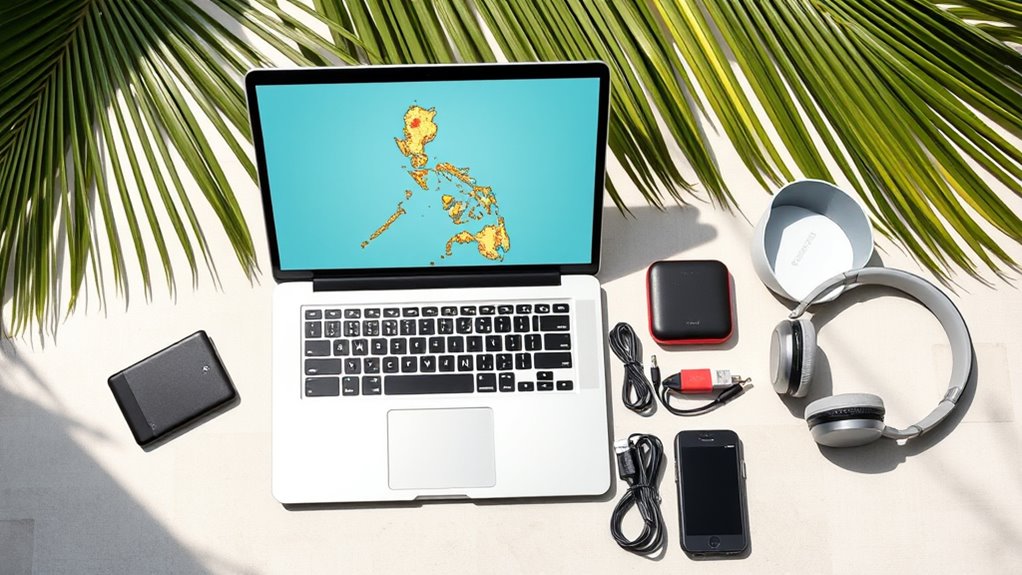
Electronics and accessories play an essential role in ensuring your trip to the Philippines is enjoyable and hassle-free.
Electronics and accessories are crucial for a smooth and enjoyable experience during your trip to the Philippines.
First, bring a smartphone with eSIM capabilities for seamless connectivity. Don’t forget a power bank to keep your devices charged during outages. A universal adapter is vital since the country uses Type A, B, and C plugs.
Waterproof phone pouches and camera cases will protect your devices from water and dust. For entertainment, consider a tablet or e-reader, and pack noise-canceling headphones for relaxation.
If you’re into photography, a waterproof camera and extra memory cards are must-haves. Finally, portable Wi-Fi hotspots can keep you connected in remote areas, making your journey smoother.
Toiletries and Hygiene Products
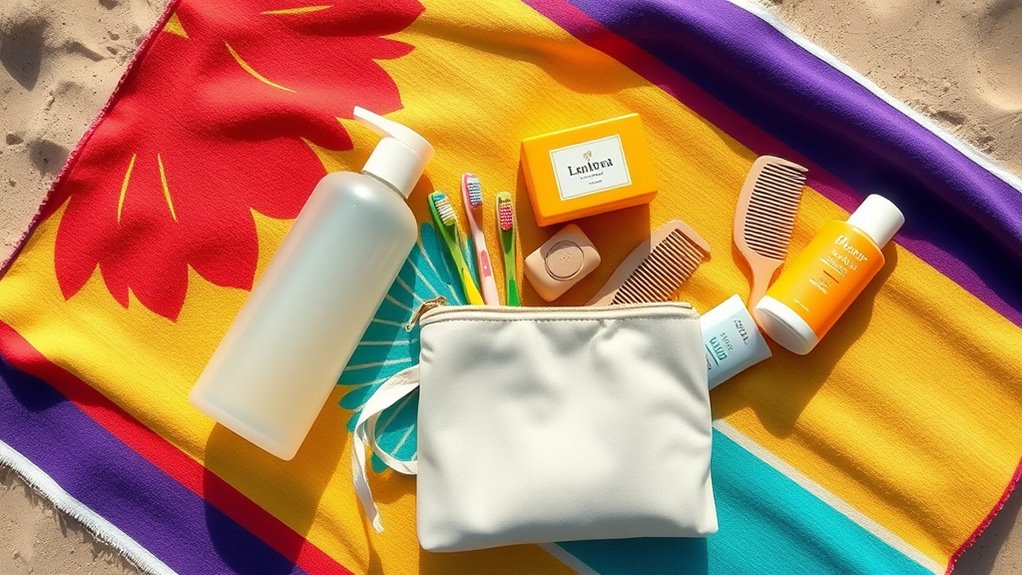
When planning your trip to the Philippines, packing the right toiletries and hygiene products is vital for a comfortable experience.
Start with sunscreen (SPF 50+) to protect against the tropical sun and insect repellent to ward off mosquitoes. Include travel-sized shampoo, conditioner, toothpaste, and deodorant for convenience. It’s also wise to consider natural remedies for any minor skin irritations that may arise.
Don’t forget a moisturizer, like aloe vera gel, to soothe sunburned skin. If you need feminine hygiene products, make certain you have enough, as they may be scarce in remote areas. Additionally, consider packing aftercare essentials to maintain hygiene for any piercings you may have.
A basic first aid kit and stomach remedies are also essential. Finally, pack a toothbrush, mouthwash, and lip balm with SPF to maintain oral and skin health amid the heat.
Stay fresh and comfortable!
Safety and Security Measures
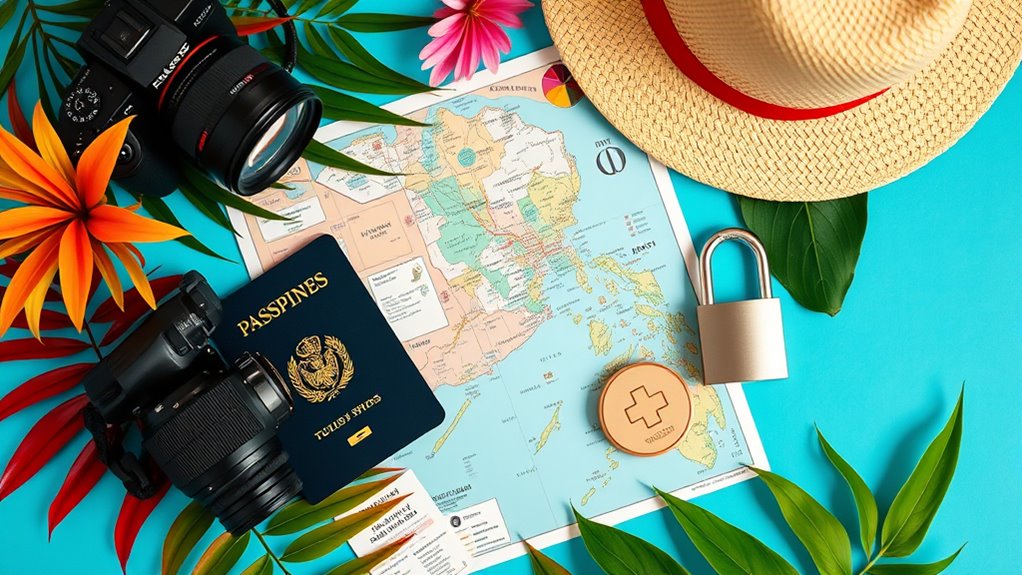
Safety and security are paramount when traveling to the Philippines. Exercise caution by avoiding displays of wealth, as crime rates can be high. Protect your belongings by securing valuables in cut-proof bags and carrying only needed cash.
Stay aware of your surroundings, especially in crowded areas where pickpocketing occurs. Avoid lonely situations and be wary of unsolicited help from strangers.
When it comes to road safety, always use official taxis, wear helmets on motorcycles, and don’t drive at night. Ascertain you have the proper driving permits and insurance if you plan to drive.
Finally, check for required vaccinations and be cautious with food and water safety to maintain your health during your trip.
Activities and Transportation Options
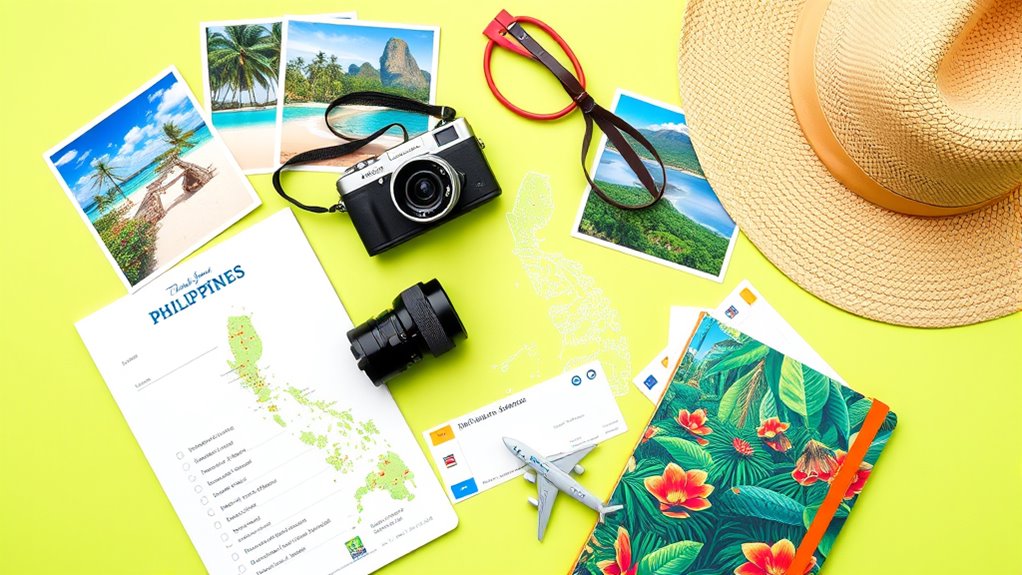
The Philippines offers a wealth of activities and transportation options that cater to all types of travelers. You can unwind on pristine beaches like White Beach or El Nido, or immerse yourself in adventure with water sports, such as kayaking at Panagsama Beach.
For a dose of history, explore Intramuros in Manila. If you’re feeling adventurous, trek Taal Volcano or discover Palawan’s underground river.
Getting around is easy, too. Affordable flights with airlines like AirAsia connect you to various islands. You can use ferry services through platforms like Bookaway, or grab a ride with Grab in cities.
Getting around the Philippines is a breeze with affordable flights, ferry services, and convenient rides via Grab.
For local exploration, consider renting a motorbike, or hop on a jeepney for an authentic experience.
Currency and Local Budgeting
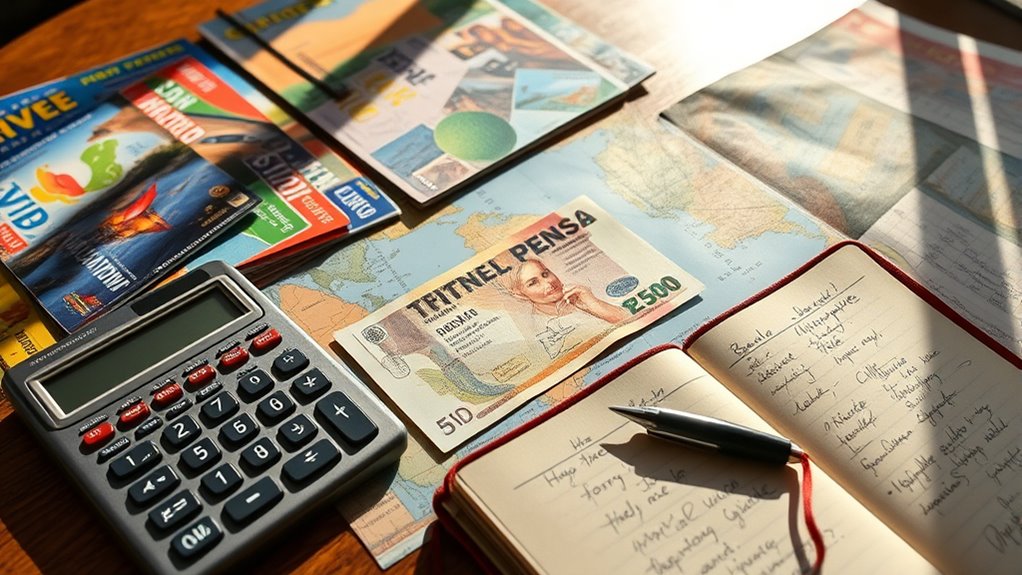
Understanding the local currency and budgeting is essential for making the most of your trip to the Philippines. The Philippine peso (PHP) is the primary currency, and you’ll find that local businesses prefer it, although USD is accepted in tourist areas.
You can exchange your money at banks, currency exchange offices, or ATMs, which are widely available. A daily budget of 1,500 to 3,000 PHP should cover basic meals and accommodations. Meals at local eateries cost around 50 to 150 PHP, while budget hotels start at about 800 PHP per night.
To manage your expenses, consider using budgeting apps and keep a mix of cash and credit cards for convenience. Don’t forget to check current exchange rates for better deals.
Cultural Etiquette and Local Customs
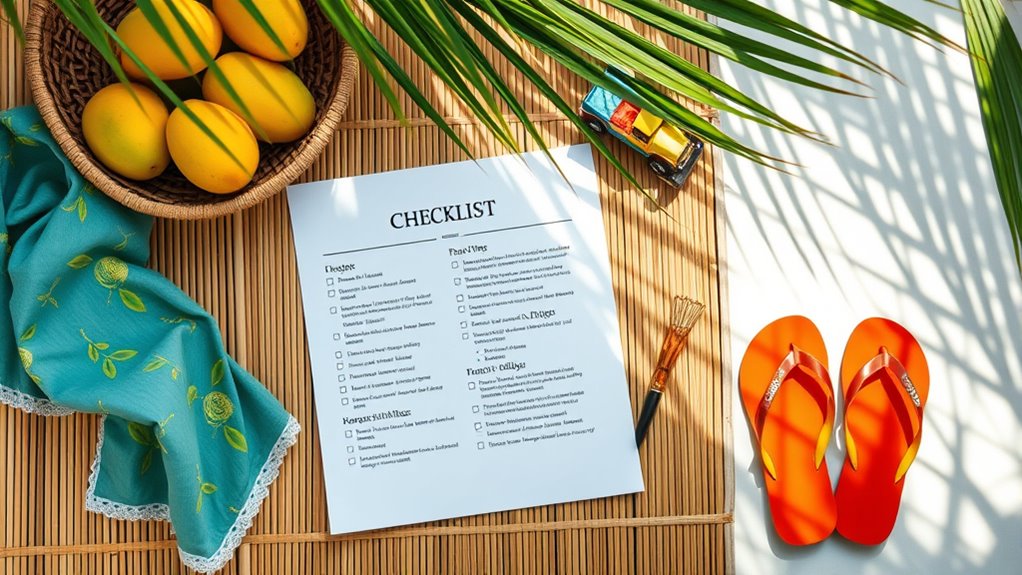
While exploring the Philippines, it’s essential to embrace the rich cultural etiquette and local customs that shape daily life.
Respect for elders is paramount; address them as “Tita” or “Kuya” to show deference. Family ties run deep, so expect many gatherings. Modest dress is appreciated, reflecting local values.
Filipinos are known for their warm hospitality, often inviting you to share a meal—declining food can be seen as impolite. Remember to remove your shoes before entering a home and always graciously accept refreshments.
Engage in open communication while being mindful of “hiya,” the aversion to causing shame. Finally, adapt to local practices like the “mano” gesture to honor elders and appreciate the community’s spirit.
Frequently Asked Questions
What Languages Are Commonly Spoken in the Philippines?
Language in the Philippines is like a vibrant tapestry, woven with diverse threads of culture. You’ll find Filipino and English as the official languages, with Filipino being widely taught.
Indigenous languages like Cebuano, Tagalog, Ilocano, and Hiligaynon dominate home conversations. Each region boasts its dialects, reflecting local customs.
As you explore, you’ll discover how these languages enrich the Filipino identity, intertwining with traditions, folklore, and the arts, forming a unique cultural mosaic.
How Can I Communicate With Locals if I Don’t Speak Tagalog?
If you don’t speak Tagalog, don’t worry! You can communicate easily since English is widely spoken in the Philippines.
Try using simple local phrases like “Salamat” for thank you; locals appreciate the effort. Rely on hand gestures and smiles to convey your message when needed.
Translation apps can also be a lifesaver. Just ask for help politely, and you’ll find that Filipinos are friendly and enthusiastic to assist you.
Enjoy your interactions!
Are There Any Local Festivals or Events During My Visit?
Yes, there are plenty of local festivals and events happening during your visit!
Check the specific month you’re traveling to discover unique celebrations. For example, if you’re there in February, you might catch the Paraw Regatta or the Feast Day of Santa Clara.
In May, enjoy the vibrant Kaogma Festival. Engaging in these festivities will immerse you in the culture, offering a memorable experience with locals and traditions!
Is It Safe to Drink Tap Water in the Philippines?
It’s generally not safe to drink tap water in the Philippines. Most areas lack reliable water treatment, which means you could face health risks from contaminants.
While places like Metro Manila and Cebu City have improved water quality, it’s still best to avoid tap water altogether. Opt for bottled or filtered water instead.
If you find yourself in rural areas, consider boiling or using portable water filters to guarantee your safety.
What Are the Tipping Customs in Restaurants and for Services?
When you’re in the Philippines, tipping customs can vary.
In most restaurants, a 10% service charge is included, so extra tipping’s only for exceptional service.
For taxis, rounding up the fare is polite.
In hotels, consider tipping housekeeping ₱20-50 daily and porters ₱50 per bag.
For delivery drivers, ₱20-50 is appreciated.
Remember, tipping’s voluntary and reflects your satisfaction with the service you receive.
Enjoy your experience!
Conclusion
Now that you’ve got your checklist in hand, it’s time to embrace the adventure that awaits you in the Philippines. Remember, every moment is a chance to create unforgettable memories. So, pack your bags and let the vibrant culture and stunning landscapes ignite your spirit of exploration! After all, isn’t life just a collection of stories waiting to be told? Get ready to plunge into an experience that’ll leave you longing for more!
